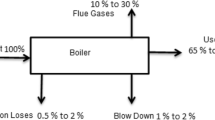The importance of improving the performance efficiency of the thermal power plants is ever-increasing. This is caused by a number of factors. One of the most significant factors is an increase in the share of basic equipment with the service life approaching or exceeding the expected limit. The basic equipment, first of all, includes boiler units. Currently, an increase in the performance efficiency of the boiler units is mainly achieved by utilizing the thermal effectiveness reserve. A number of documents have been developed, including the manual on calculating the standard technical and economic parameters, procedure for calculating the degree of utilization of the thermal effectiveness reserves, recommended practices for preparing reports on thermal effectiveness of the power plants, etc. It is noted that the thermal effectiveness reserve depends on the level of operation and technical condition of the equipment. Assuming that the level of operation affects the extent of the thermal effectiveness reserve less than the technical condition of the equipment, a natural question arises: why the rate of wear is referred to as a reserve. This completely contradicts the reserve condition used during operation. It is shown that the variation in the rated technical and economic parameters practically does not affect the variation in the specific consumption of reference fuel and efficiency. Moreover, their relationship may be contrary to common sense. It is noted that an increase in performance efficiency of the power units can be achieved by switching from attempting to utilize the “thermal effectiveness reserve” to a possibility of comparing the power units, ranking them, defining “weak links,” and advancing the personnel qualification.
Similar content being viewed by others
References
RD 34.09.454. Generic Algorithm for Calculating Technical and Economic Parameters of 300, 500, 800, and 1200 MW Condensing Power Units [in Russian].
T. N. Fursova, “Automation of determining and analyzing technical and economic parameters of the power units”, in: Sb. Nauch. St. Ukr. Inzh.-Ped. Akad., No. 9, 233 – 244 (2012).
E. M. Farkhadzade, A. Z. Muradaliev, Yu. Z. Farzaliev, T. K. Rafieva, and S. A. Abdullaeva, “Minimizing the risk of erroneous decision when assessing the importance of statistical relations between technical and economic parameters of the objects of electric power systems”, Énergetika, 61(3), 193 – 206 (2018).
E. M. Farkhadzade, A. Z. Muradaliev, S. M. Ismailova, and R. F. Yusifli, “Method and algorithm for predicting hazardous technical conditions of the objects of electric power systems”, Élektrichestvo, No. 4, 12 – 186 (2019).
E. M. Farkhadzade, A. Z. Muradaliev, E. I. Dzhalagova, and S. A. Abdullaeva, “Method and algorithm for comparing the performance of the gas engine power plants of electric power systems”, Izv. RAN. Énergetika, No. 2 (2019).
E. M. Farkhadzade, A. Z. Muradaliev, Yu. Z. Farzaliev, and S. A. Abdullaev, “Comparison and ranking of the steam turbine plants of the thermal power plant power units based on performance efficiency”, Teploénergetika, No. 10, 41 – 49 (2018).
Author information
Authors and Affiliations
Corresponding author
Additional information
Translated from Élektricheskie Stantsii, No. 8, August 2019, pp. 14 – 17.
Rights and permissions
About this article
Cite this article
Farkhadzade, E.M., Muradaliev, A.Z., Rafieva, T.K. et al. Improving the Performance Efficiency of the Power Units of Thermal Power Plants. Power Technol Eng 53, 581–584 (2020). https://doi.org/10.1007/s10749-020-01119-9
Published:
Issue Date:
DOI: https://doi.org/10.1007/s10749-020-01119-9



